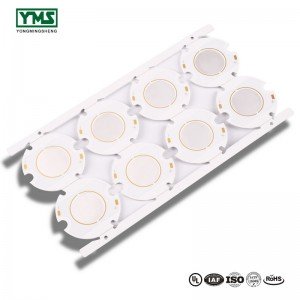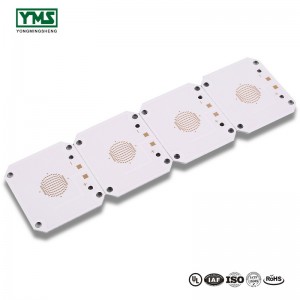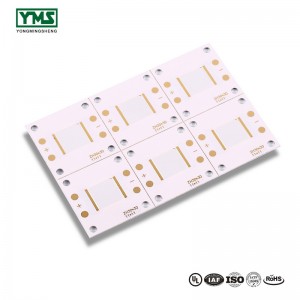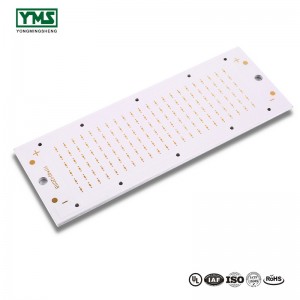Working principle of aluminum base board
The surface of the power device is mounted on the circuit layer, and the heat generated during the operation of the device is rapidly transmitted to the metal base layer through the insulation layer, and then the metal base layer transfers the heat out, so as to realize the heat dissipation of the device.
Compared with the traditional fr-4, the aluminum base board can reduce the thermal resistance to the minimum, so that the aluminum base board has excellent thermal conductivity. Compared with the thick film ceramic circuit, its mechanical properties are excellent.
In addition, aluminum base board has the following unique advantages:
Meet RoHs requirements;
More suitable for SMT process;
In the circuit design scheme, heat diffusion is treated effectively to reduce the module operating temperature, prolong the service life, and improve the power density and reliability.
Reduce the assembly of radiators and other hardware (including thermal interface materials), reduce the volume of products, and reduce the cost of hardware and assembly;
Optimize power circuit and control circuit;
Replace fragile ceramic base board for better mechanical endurance.
Led lighting aluminum base board
What is aluminum base board proofing
Aluminum base board proofing refers to the process of printing, the use of photographic methods or electronic color separators made and properly modified film, in large quantities before printing, first printed proof.
The purpose of this is to confirm whether the equipment, handling and operation in the printing process are correct and to provide customers with samples that meet the requirements of users. Proofing does not require the same visual quality as the final product.
Aluminum base board proofing method
There are two main types of proofing. One is hard proofing, such as mechanical proofing, pre-proofing of light-sensitive materials proofing, inkjet proofing and so on. Another kind is soft proofing, such as screen display.
Mechanical proofing
Machinery is also called analog proofing. Is in commonly under the condition of basically the same, and printing conditions, such as paper, ink, printing mode, etc.), have good plate, using original installation on the proofing, printing, get the sample, then compare the original pattern or format design proofread, until order, color, text, page size right, finally signed by the customer, can be printed.
Mechanical proofing, although is to simulate the printing of the, but mechanical proofing ink transfer principle, the use of printing materials and printing environment often do not match the actual printing, therefore, from the sample of proofing machine to get the original color, reproducibility and printing machines for image there are differences, in order to narrow the, differences between the current has developed the multi-color automatic machines, and applied to the production of printing.
Preproofing does not require printing plate, paper, ink and proofing machine, but use special photosensitive material, apply the principle of optics and photochemistry, obtain color sample or display with display screen, find the problems in image information processing, correct in time, improve the efficiency of mechanical proofing.
(1) Photographic material proofing method. This method includes color chip stacking method, color stacking method and electrostatic proofing method. The photosensitive material coated on the film base, and then the corresponding separations plus screen film closely attached, exposure, made of monochrome yellow, magenta, green, black, will be superimposed together, combined into a color image. Also in order to transfer the color layer of monochrome pieces to the proofing substrate, forming a color proof.
(2) Computer aided proofing. This method includes soft proofing and hard proofing.
Soft proofing, the use of computer-aided color proofing system, in the display screen to see the color image, can not get the sample.Hard proofing, the use of color page Mosaic system output data, in the hard proofing system to obtain samples.
Hard proofing system, generally by the display terminal, keyboard, floppy disk drive device, laser recording system and online photo development machine.Can also be the whole page of the collage machine data, through the color inkjet to obtain the sample.
(3) Electronic proofing. This proofing method is mainly adapted to the increasingly developed color desktop publishing system, using inkjet printers or thermal sublimation printers to obtain samples. An ink-jet printer, in which a thin nozzle is mounted on the print head to spray ink onto paper.
There are multiple models with four print heads, three print heads and one print head. Thermal sublimation printers, in which a number of thermal sensors are installed on the print head, melt the transparent dye from the colored ribbon onto the paper, and cover each color with the other to create a color image similar to a photo.
Aluminum base board proofing process
1. Laminate Shear
Objective: according to the requirements of engineering data MI, cut the large sheet to produce the sheet parts.Small pieces of board to meet customer requirements.
Process: large plate material → cutting plate according to MI requirements → curium plate → beer rounded corners \ edge grinding → plate out
2. Drilling,
Objective: according to the engineering data, drill the desired aperture in the corresponding position on the board with the required size.Process: laminated pin → upper plate → drilling → lower plate → inspection \ repair
3. PTH
Objective: to deposit a thin layer of copper on the wall of insulating hole by chemical method.
Process: coarse grinding → hanging plate → copper automatic line → lower plate → 1% dilute H2SO4→ thickened copper
4. Graph Transfer
Objective: graphic transfer is the production of film on the image transfer to the board
Process: (blue oil process) : grinding plate → first printing side → drying → second printing side → drying → blasting → developing → inspection;(dry film process) : laminate plate → pressing film → static → contraption → exposure → static → developing → examination
5. Pattern Plating
Objective: pattern electroplating is to electroplate a copper layer and a gold, nickel or tin layer of required thickness on the exposed copper skin or hole wall of the circuit pattern.
Process: upper plate → degreasing → washing twice → slight erosion → washing → pickling → copper plating → washing → acid pickling → tin plating → washing → lower plate
6. Film Remove
Objective: to use NaOH solution to recede the anti – electroplating coating to expose the non – line copper layer.
Process: water film: socket → leaching alkali → washing → scrubbing → machine;Dry film: off board → off machine
7. Etching
Objective: to etch the copper layer in non – line part by chemical reaction.
8. Solder Mask
Objective: green oil is to transfer the pattern of green film onto the board to protect the circuit and prevent the soldering of parts on the circuit
Process: grinding plate → printing photosensitive green oil → curium plate → exposure → impact;Grinding plate → printing first side → baking plate → printing second side → baking plate
9. Silk Screen
Purpose: a character is provided as a recognizable marker
Process: after green oil finish curium → cooling and standing → mesh adjustment → character printing → after-curium
10. Lead-free Hasl
Objective: spraying tin is to spray a layer of lead tin on the exposed copper surface which is not covered with solder oil to protect the copper surface from corrosion and oxidation and to ensure good welding performance.
Process: slight erosion → air drying → preheating → rosin coating → solder coating → hot air leveling → air cooling → washing air drying
11. Final Shaping
Objective: to produce the desired shapes of organic gongs, bioben, hand cut gongs through die stamping or CNC gongs
Data gongs machine board and the precision of the board is high, the second, the hand cutting board can only do some simple shape.
12. Electrical Test
Objective: through electronic 100% test, it can detect the defects which are hard to be found visually, such as open circuit, short circuit and so on.
Process: upper die → plate setting → test → pass →FQC visual inspection → disqualify → repair → return test →OK→REJ→ scrap
13. Finally Quality Control
Objective: to prevent defects and defective parts from flowing out by 100% visual inspection and repair of minor defects.
Specific work process: incoming materials → view data → eye inspection → qualified →FQA spot check → qualified → packaging → unqualified → treatment → inspection OK
Yongmingsheng is an aluminum base board manufacturer, please contact us ~
Post time: Sep-03-2019




